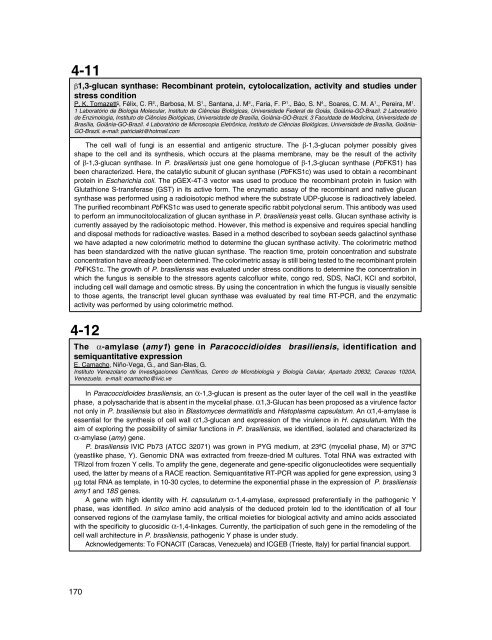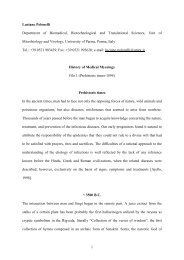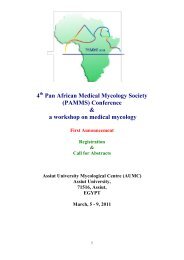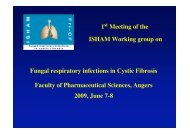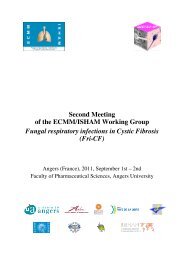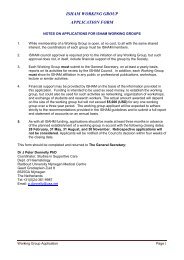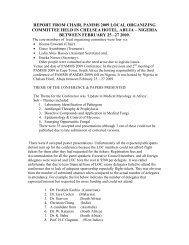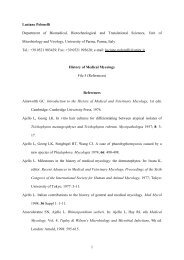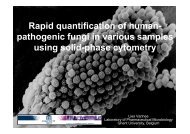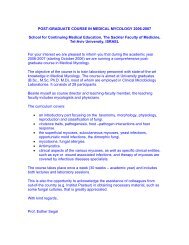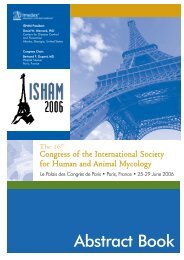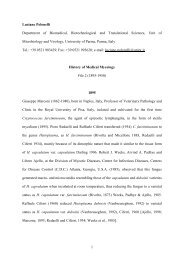4-11β1,3-glucan synthase: Recombinant protein, cytolocalization, activity and studies understress conditionP. K. Tomazett 1 , Félix, C. R 2 ., Barbosa, M. S 1 ., Santana, J. M 3 ., Faria, F. P 1 ., Báo, S. N 4 ., Soares, C. M. A 1 ., Pereira, M 1 .1 Laboratório de Biologia Molecular, Instituto de Ciências Biológicas, Universidade Federal de Goiás, Goiânia-GO-Brazil. 2 Laboratóriode Enzimologia, Instituto de Ciências Biológicas, Universidade de Brasília, Goiânia-GO-Brazil. 3 Faculdade de Medicina, Universidade deBrasília, Goiânia-GO-Brazil. 4 Laboratório de Microscopia Eletrônica, Instituto de Ciências Biológicas, Universidade de Brasília, Goiânia-GO-Brazil. e-mail: patriciakt@hotmail.comThe cell wall of fungi is an essential and antigenic structure. The β-1,3-glucan polymer possibly givesshape to the cell and its synthesis, which occurs at the plasma membrane, may be the result of the activityof β-1,3-glucan synthase. In P. brasiliensis just one gene homologue of β-1,3-glucan synthase (PbFKS1) hasbeen characterized. Here, the catalytic subunit of glucan synthase (PbFKS1c) was used to obtain a recombinantprotein in Escherichia coli. The pGEX-4T-3 vector was used to produce the recombinant protein in fusion withGlutathione S-transferase (GST) in its active form. The enzymatic assay of the recombinant and native glucansynthase was performed using a radioisotopic method where the substrate UDP-glucose is radioactively labeled.The purified recombinant PbFKS1c was used to generate specific rabbit polyclonal serum. This antibody was usedto perform an immunocitolocalization of glucan synthase in P. brasiliensis yeast cells. Glucan synthase activity iscurrently assayed by the radioisotopic method. However, this method is expensive and requires special handlingand disposal methods for radioactive wastes. Based in a method described to soybean seeds galactinol synthasewe have adapted a new colorimetric method to determine the glucan synthase activity. The colorimetric methodhas been standardized with the native glucan synthase. The reaction time, protein concentration and substrateconcentration have already been determined. The colorimetric assay is still being tested to the recombinant proteinPbFKS1c. The growth of P. brasiliensis was evaluated under stress conditions to determine the concentration inwhich the fungus is sensible to the stressors agents calcofluor white, congo red, SDS, NaCl, KCl and sorbitol,including cell wall damage and osmotic stress. By using the concentration in which the fungus is visually sensibleto those agents, the transcript level glucan synthase was evaluated by real time RT-PCR, and the enzymaticactivity was performed by using colorimetric method.4-12The α-amylase (amy1) gene in Paracoccidioides brasiliensis, identification andsemiquantitative expressionE. Camacho, Niño-Vega, G., and San-Blas, G.Instituto Venezolano de Investigaciones Científicas, Centro de Microbiología y Biología Celular, Apartado 20632, Caracas 1020A,Venezuela. e-mail: ecamacho@ivic.veIn Paracoccidioides brasiliensis, an α-1,3-glucan is present as the outer layer of the cell wall in the yeastlikephase, a polysacharide that is absent in the mycelial phase. α1,3-Glucan has been proposed as a virulence factornot only in P. brasiliensis but also in Blastomyces dermatitidis and Histoplasma capsulatum. An α1,4-amylase isessential for the synthesis of cell wall α1,3-glucan and expression of the virulence in H. capsulatum. With theaim of exploring the possibility of similar functions in P. brasiliensis, we identified, isolated and characterized itsα-amylase (amy) gene.P. brasiliensis IVIC Pb73 (ATCC 32071) was grown in PYG medium, at 23ºC (mycelial phase, M) or 37ºC(yeastlike phase, Y). Genomic DNA was extracted from freeze-dried M cultures. Total RNA was extracted withTRIzol from frozen Y cells. To amplify the gene, degenerate and gene-specific oligonucleotides were sequentiallyused, the latter by means of a RACE reaction. Semiquantitative RT-PCR was applied for gene expression, using 3µg total RNA as template, in 10-30 cycles, to determine the exponential phase in the expression of P. brasiliensisamy1 and 18S genes.A gene with high identity with H. capsulatum α-1,4-amylase, expressed preferentially in the pathogenic Yphase, was identified. In silico amino acid analysis of the deduced protein led to the identification of all fourconserved regions of the αamylase family, the critical moieties for biological activity and amino acids associatedwith the specificity to glucosidic α-1,4-linkages. Currently, the participation of such gene in the remodeling of thecell wall architecture in P. brasiliensis, pathogenic Y phase is under study.Acknowledgements: To FONACIT (Caracas, Venezuela) and ICGEB (Trieste, Italy) for partial financial support.170
4-13Mating type genes MAT1-1 and MAT1-2 and sexual reproduction in Paracoccidioides brasiliensisTorres I1,5, García AM1,4, McEwen JG1,2,3, Gonzalez A4, Restrepo A1, Arango M1,2.1. Unidad de Biología Celular e Inmunogenética-Corporación para Investigaciones Biológicas-CIB. Medellín, Colombia. 2. Departamento deMicrobiología y Parasitología-Universidad de Antioquia. Medellín, Colombia. 3. Departamento de Fisiología y Bioquímica -Universidad de Antioquia.Medellín, Colombia. 4. Universidad Pontificia Bolivariana-Facultad de Medicina. Medellín, Colombia. 5. Estudiante de doctorado en Biología-Facultadde Ciencias Exactas y Naturales- Universidad de Antioquia. Medellín, Colombia. 4. Escuela de Microbiología U de A. e-mail: isaurap10@gmail.com,myrthaarango@yahoo.com.Introduction: Paracoccidioides brasiliensis (Pb) taxonomic classification has not yet been defined.Nevertheless, some morphological, molecular and phylogenetic studies have placed the fungus as a member ofthe phylum Ascomycota even if its sexual cycle and mating type system remain unknown. The aim of this work wasto demonstrate the presence of both MAT genes in Pb and perform some crosses between potentially compatiblepartners by plating in different culture media. Methods: 76 Pb isolates from a variety of sources (geographic,clinical, environmental and phylogenetics species) were analyzed in an attempt to find mating type genes.Specific primers were designed from Pb ESTs libraries and the MAT genes sequences derived from Histoplasmacapsulatum. Samples corresponding to the above isolates were assessed by PCR by means of these specificprimers and the mating genotype was assigned according to the amplicons’ size thus obtained. Some ampliconswere sequenced and analyzed by means of the BLAST and Expasy tools. Some isolates were selected accordingto certain characteristics such as mating type, phylogenetic species, country of origin and were then crossed onsynthetic media, Results: The PCR assays were successful as the presence of both mating type genes wasmade evident in all Pb isolates tested with an amplicon of 400pb corresponding to the MAT1-1 gen (heterothallic)and fragments of 300pb and/or 1000pb corresponding to the MAT1-2 gen (heterothallic). Interestingly, there wasa group that showed both the MAT1-1 and the MAT1-2 amplicons (“homothallic”). Homology analysis from Pbsequences performed with BLAST tools, showed a high grade of identity and importat e-values when comparedwith MAT genes from others Ascomycetes. However, the same analysis in “homothallic” isolates showed that one ofthese genes was a truncated copy, not being therefore true homothallism. Protein analysis (Expasy) revealed thatPb MAT1-1 and MAT1-2 had the characteristic alpha and HMG boxes, respectively. When the crosses performedon synthetic media were analyzed some structures resembling fruiting bodies were observed, but their content didnot correspond to the expected reproductive structures; there were neither asci nor ascospores. Conclusions:This study allowed to develop a PCR assay that used specific primers and permited identification of MAT genes inPb isolates. In the future, this finding may allow to improve the taxonomic classification of this fungus The presenceof both genes suggest that sexual reproduction may occur in Pb and that, at the moment, additional crosses withdifferent partners, with emphasis in crossing the phylogenetic species, are under way, and may point towards amore precise definition of the concept of biological species in the Pb population.4-14Molecular evidences of sexual reproduction in P. brasiliensisTeixeira, M. M., Paes, H. C, Fernandes, L., Silva, S. S. and Felipe, M.S.S.Instituto de Biologia, UnB, Brasilia - Brasil.e-mail: marcus.teixeira@gmail.comBackground and aims: The thermodimorphic fungus P. brasiliensis is the aetiological agent ofParacoccidioidomycosis (PCM). The teleomorph form of this fungus has never been observed either in vitro or invivo. Recently, through phylogenetic analysis by concordance and non-discordance methods and by recombinationanalysis, it was suggested that P. brasiliensis has a sexual stage in its life cycle (Matute et al., 2006). Here weshow that this pathogen has sex-suggestive features and contains homologues to all genes that comprise themating machinery in other fungal species. Methods: Based on the transcriptome of the isolate Pb01 and thestructural genome of the isolate Pb3 we designed two pairs of primers to amplify the transcriptional factors α-boxand HMG that correlate to both idiomorphs (MAT1.1 and MAT 1.2 respectively). We amplified the cognate regionsfrom 29 isolates that represent the three phylogenetic species of P. brasiliensis (S1, PS2 and PS3) and isolatesfrom “Pb01-like”. We also performed in silico analysis of the structural genome of Pb3 to search for potentialgenes involved in mating as described in Histoplasma capsulatum, Aspergillus fumigatus and Saccharomycescerevisiae. We performed a direct blastX of these genes against the structural genome of P. brasiliensis isolatePb3. Results: For the 29 isolates we were able to amplify three populations: i) 15 isolates that present only theα-box domain (MAT1.1); ii) 8 isolates that present only the HMG (MAT1.2); and iii) 6 isolates that present boththe α-box and HMG (MAT1.1 and MAT1.2). The in silico analysis showed that P. brasiliensis isolate Pb3 containsthe core genes involved in mating with high similarity to H. capsulatum, such as pheromone-processing enzymes(ste14, ste24, ste6, ste13, ram1, ram2, kex1 and kex2), components of a pheromone-response pathway (GBA1,ste4, ste18, ste20, ste11, ste7, fus3) and pheromone receptors (ste2 and ste3). Conclusion: These resultssuggest that P. brasiliensis may undergo mating and then meiosis during its life cycle. This work opens newavenues of investigation into the possibility of in vivo or in vitro mating in this pathogen.171


